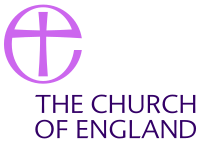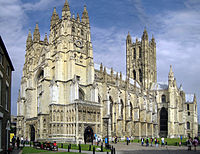Church of England: Difference between revisions
Created page with 'thumb|200px|right|Canterbury Cathedral The '''Church of England''' is the established Christian church by law in Engl…' |
mNo edit summary |
||
| Line 1: | Line 1: | ||
[[File:Logo of the Church of England.svg|right|200px]] | |||
[[File:Canterbury Cathedral - Portal Nave Cross-spire.jpeg|thumb|200px|right|Canterbury Cathedral]] | [[File:Canterbury Cathedral - Portal Nave Cross-spire.jpeg|thumb|200px|right|Canterbury Cathedral]] | ||
The '''Church of England''' is the established Christian church by law in England.<ref>{{cite web|url=http://www.cofe.anglican.org/about/history/ |title=The History of the Church of England |publisher=The Archbishops' Council of the Church of England|accessdate=2006-05-24}}</ref>. It is considered the ''Mother Church'' of the worldwide Anglican Communion. The Church of England also extends to the [[Isle of Man]] (the [[Diocese of Sodor and Man]]), to the [[Channel Islands]] (which fall within the [[Diocese of Winchester]], to certain parishes in [[Flintshire]], [[Monmouthshire]] and [[Radnorshire]] and to [[Gibraltar]]. Several Anglican communities in continental Europe and beyond fall within the Church of England's [[Diocese of Gibraltar in Europe]]. | The '''Church of England''' is the established Christian church by law in England.<ref>{{cite web|url=http://www.cofe.anglican.org/about/history/ |title=The History of the Church of England |publisher=The Archbishops' Council of the Church of England|accessdate=2006-05-24}}</ref>. It is considered the ''Mother Church'' of the worldwide Anglican Communion. The Church of England also extends to the [[Isle of Man]] (the [[Diocese of Sodor and Man]]), to the [[Channel Islands]] (which fall within the [[Diocese of Winchester]], to certain parishes in [[Flintshire]], [[Monmouthshire]] and [[Radnorshire]] and to [[Gibraltar]]. Several Anglican communities in continental Europe and beyond fall within the Church of England's [[Diocese of Gibraltar in Europe]]. | ||
Latest revision as of 12:28, 12 December 2010


The Church of England is the established Christian church by law in England.[1]. It is considered the Mother Church of the worldwide Anglican Communion. The Church of England also extends to the Isle of Man (the Diocese of Sodor and Man), to the Channel Islands (which fall within the Diocese of Winchester, to certain parishes in Flintshire, Monmouthshire and Radnorshire and to Gibraltar. Several Anglican communities in continental Europe and beyond fall within the Church of England's Diocese of Gibraltar in Europe.
Doctrine and practice
Church of England doctrine can be summarised in its canon law as follows:
"The doctrine of the Church of England is grounded in the Holy Scriptures, and in such teachings of the ancient Fathers and Councils of the Church as are agreeable to the said Scriptures. In particular such doctrine is to be found in the Thirty-nine Articles of Religion, The Book of Common Prayer, and the Ordinal."[2]
Ireland and Wales
The Fifth Article of the Union with Ireland Act 1800 provided that:
That it be the Fifth Article of Union, That the Churches of England and Ireland, as now by Law established, be united into one Protestant Episcopal Church, to be called, The United Church of England and Ireland; and that the Doctrine, Worship, Discipline, and Government of the said United Church shall be, and shall remain in full force for ever, as the same are now by Law established for the Church of England; and that the Continuance and Preservation of the said United Church, as the established Church of England and Ireland, shall be deemed and taken to be an essential and fundamental Part of the Union.
This one, Protestant Episcopal Church was united for just 70 years, the Irish part of the church being separated and disestablished on 1 January 1871 by the Irish Church Act 1869. It became the Church of Ireland once again.
The parishes in Wales were separated from the Church of England by the Welsh Church Act 1914, coming into effect on 31 March 1920. Not only was the Welsh church disestablished but also disendowed. This created the Church in Wales.
Structure

The Queen has the constitutional title of Supreme Governor of the Church of England and canon law states that We acknowledge that the Queen’s most excellent Majesty, acting according to the laws of the realm, is the highest power under God in this kingdom, and has supreme authority over all persons in all causes, as well ecclesiastical as civil.
The General Synod is the chief governing body of the Church of England.
The church is structured as follows (from the lowest level upwards):
- Province There are two provinces, of Canterbury and York, each under the jurisdiction of an archbishop. A province is divided into dioceses.
- Diocese. This is the area under the jurisdiction of a diocesan bishop, and it will have a cathedral. Within the diocese may be one or more assisting bishops, called suffragan bishops. The Diocese will have a Diocesan Synod. There are 30 dioceses in the Province of Canterbury and 14 dioceses in the Province of York.
- Archdeaconry. This is a division of a diocese in which an archdeacon has functions.
- Deanery This is a grouping of parishes and the incumbent of one of the parishes will be chosen as the rural dean. The Deanery will have a Deanery Synod, whose members have a vote in the election of representatives to the diocesan synod.
- Parish, this is the most local level, often consisting of one church building and community, although nowadays many parishes are joining forces in a variety of ways. The parish will be looked after by a parish priest who may be entitled "vicar" or "rector" or "priest in charge". The parish will have a Parochial Church Council consisting of the parish clergy and elected representatives from the congregation. The Diocese of Gibraltar in Europe is not formally divided into parishes.
Some local churches do not have a parish. In urban areas there are a number of proprietary chapels (mostly built in the 19th century to cope with urbanisation and growth in population). Also in more recent years there are increasingly church plants and fresh expressions of church, whereby new congregations are planted in a variety of locations (such as schools or pubs) in order to spread the Gospel of Christ in fresh and non-traditional ways.

A Peculiar is a church outside any bishop's jurisdiction. There are just a few peculiars, mainly Royal Peculiars such as Westminster Abbey, the Savoy Chapel and St George's Chapel in Windsor Castle.
No clergy can be instituted and inducted into a parish without swearing the Oath of Allegiance to Her Majesty, and taking the Oath of Canonical Obedience "in all things lawful and honest" to the bishop. Usually they are instituted to the benefice by the bishop and then inducted by the archdeacon into the actual possession of the benefice property—church and parsonage. Curates are appointed by rectors and vicars, but if priests-in-charge then by the bishop after consultations with the patron. Cathedral clergy (normally a dean and a varying number of residentiary canons who constitute the cathedral chapter) are appointed either by the Crown, the bishop, or by the dean and chapter themselves. Clergy officiate in a diocese either because they hold office as beneficed clergy or are licensed by the bishop when appointed (e.g. curates), or simply with permission.
References
- ↑ "The History of the Church of England". The Archbishops' Council of the Church of England. http://www.cofe.anglican.org/about/history/. Retrieved 2006-05-24.
- ↑ Canon A5: Of the doctrine of the Church of England [1]
Outside links
- Church of England official website
- Historical resources on the Church of England
- Church of England history in the West Indies
- The History Files: Churches of the British Isles, a gallery of church photos and information.